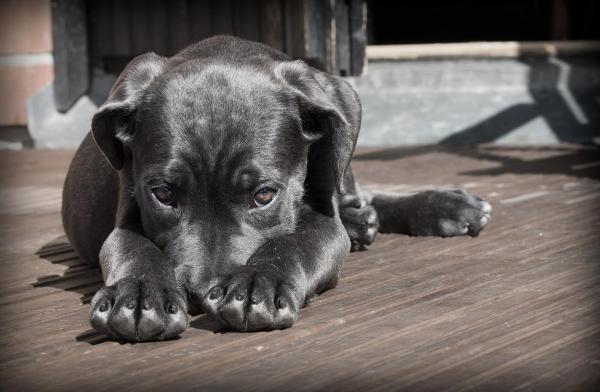
Unfortunately, there are too many cases of animal abuse. This has long-term consequences for the animal, even when it is rescued in time. Mistreated dogs are usually abandoned or removed from their so-called carers after someone makes an official complaint. Even more like other pets, these dogs need to find a new family to give them the necessary affection to finally be happy.
When you adopt an abused dog, you need to focus on recovering their trust in humans and self-esteem. This will help them get over their fear; once that's been managed, you can move on to normal training. It is a long and difficult process, but it can be done.
In many cases, people don't know how help an abused dog stop feeling scared. Inexperienced owners may give up and return the dog to the shelter, further damaging their trust. Before adopting a mistreated animal, then, you need to understand that it will take lots of patience, time and dedication. The reward, however, is truly extraordinary, as is the bond created between you and the dog.
If you're determined to adopt an animal that has gone through traumatic experiences, keep reading this AnimalWised article. We'll give you our best tips on helping an abused dog feel calm and trust again.
How to know if a dog has been abused: Common symptoms
It's possible that you have adopted a dog without knowing anything about their past. It's important to recognize the symptoms of past traumatic experiences in dogs to be able to help them feel calm and trust again, which will then allow you to train them.
The most common signs of abuse in dogs include:
- The dog is wary of people; when someone gets very close they run away to hide, or they show their teeth as a warning sign.
- The dog usually has their tail between their legs.
- The dog is not probably socialized, and they may not know how to deal with other dogs.
- They are very apathetic; they don't want to play or do any physical exercise.
- The dog almost never gets out of bed.
- The dog gets very scared when it sees certain everyday objects, such as a mop, a newspaper or a bottle. This might be because they have been hit with these items previously.
- They tend to hide.
- They suffer from very pronounced separation anxiety every time they are left alone.

Helping an abused dog recover
If you follow these tips, the dog will gradually regain their trust in humans and start their recovery until they become happy and confident again.
- Before the dog arrives at your house, prepare a safe space just for them. It should be a quiet place, away from the busiest areas of the house.
- Always use a soft, low voice when talking to them, as this transmits trust. Under no circumstances should you shout at your dog, as this will only reinforce their fears and will be like taking a backwards step.
- Never hit your dog or make any sudden moves, as this will scare them.
- Smile at your dog every time you look at it, transmitting affection and tranquility. Dogs understand non-verbal language, and this will help them slowly gain trust in you.
- Approach your dog with slow movements so that they don't get scared.
- Don't make them do anything they don't want to do; if you notice that your dog is very scared at some point, let them go to their own space so that they can calm down.
- Reward good behavior with treats and caresses, and don't punish bad behavior with anything more than a serious "no" when you catch them at it. Yours is a dog with low self-esteem, and shouting at them will difficult their recovery. Positive reinforcement is especially important.
- Take your dog for long walks, letting them get to know their surroundings. Long walks are relaxing for dogs, as exercise make them release endorpins - happiness hormones. This is best done with a long lead. If you're going to let your dog off the lead, it should be in a fenced-off area. Remember that a fearful dog is more likely to run away.
- It is important to have a regular daily routine. Set a timetable to go for walks and to feed your dog.

What to do if your dog is still scared
First of all, don't lose hope; never give up on your dog. Remember that your dog has gone through truly traumatic experiences, and a new abandonment will make things endlessly worse. Your dog needs understanding, patience and lots of love.
If you feel that the situation has grown beyond your control and you're not capable of training your fearful dog yourself, take them to a specialist who knows about helping abused dogs feel calm and trust again. A canine ethologist is the best kind of professional for this problem, and they will be able to give you very useful tips.
It may be a long journey, but with perseverance and support you'll manage to restore the dog's trust in humans. They will move on from their fears, and they will become a friend for life. The bond that you build with your dog will be unbreakable, and you'll have the satisfaction of having finally made your dog happy.

If you want to read similar articles to Helping an Abused Dog Feel Calm and Trust Again, we recommend you visit our Behavioral problems category.